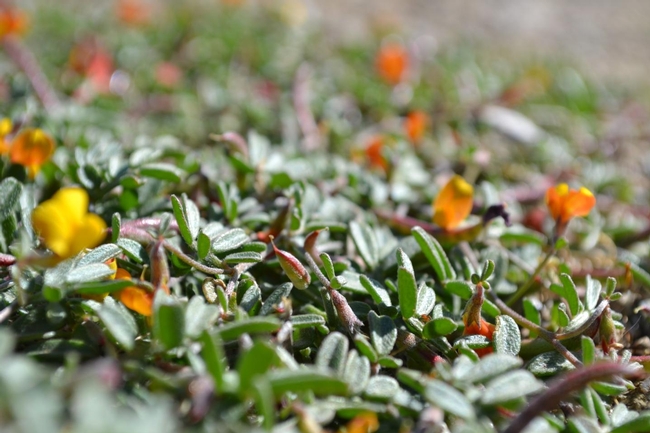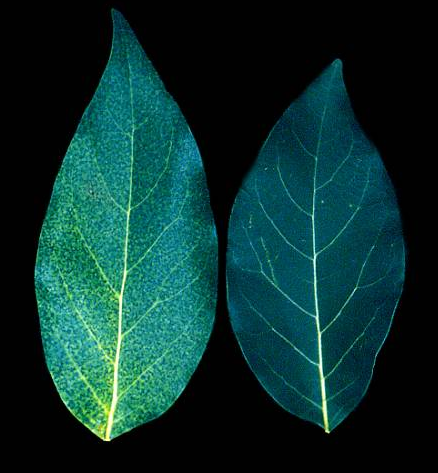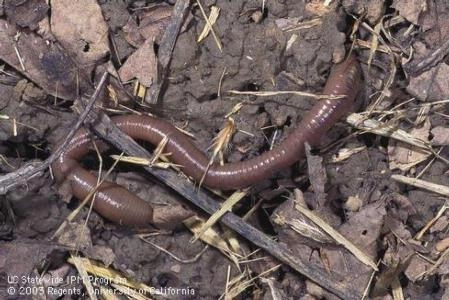
Posts Tagged: fertilizers
Microbes and Fertilizers
RIVERSIDE, Calif. -- Beautiful things can happen when plants surround themselves with the right microbes. A study on Acmispon strigosus, a plant in the pea family, showed a 13-fold growth increase in plants that partnered with a highly effective strain of the nitrogen-fixing bacteria Bradyrhizobium.
The ability of plants to use beneficial microbes to boost their growth is not lost on agronomists. Some breeders think understanding the traits that enable crops to recruit top-performing microbes is key to the future of sustainable agriculture.
A roadblock in capitalizing on the beneficial work of microbes is the complex genetic and environmental factors that govern their role in plant growth. Left unattended, plants don't always recruit beneficial microbes, instead surrounding themselves with a mix of both helpful and ineffective bacteria. Attempts to manage the microbial populations plants encounter in the soil--by inoculating with beneficial strains--have largely failed.
"It is very difficult to predict which combinations of microbes will be successful under field conditions, since the microbes that are beneficial to plants in the lab do not always compete successfully against microbes that already exist in the field," said Joel Sachs, a professor of evolutionary ecology at the University of California, Riverside and member of the university's Institute for Integrative Genome Biology. "A promising alternative is to breed plants that are better at managing their own microbial partners, an advancement that will be passed down to future generations."
In a study published today in New Phytologist, Sachs' team has advanced our understanding of how plant genetics and environmental factors affect microbial soil populations in the field. The paper's first author is Camille Wendlandt, a graduate student in Sachs' research group.
The researchers investigated whether Acmispon strigosus (the pea plant) changes how it associates with different strains of nitrogen-fixing bacteria when its environment changes. Surprisingly, they found that changing the plants' environment by fertilizing the soil did not change how plants associated with microbes. Instead, the researchers found that genetic variation between the pea plants was most important in explaining whether plants invested in relationships with the most beneficial microbes. In other words, some variants of the plant are better than others at developing these beneficial partnerships.
The variants of pea plant that were best at investing in beneficial microbes also had very high growth benefits, in contrast to other pea plant variants that did not invest as much and gained less growth benefit.
"The fact that the traits that govern these partnerships vary between plants of the same species and are heritable shows that they can be selected for by breeders," Wendlandt said. "Ultimately, we hope that agronomists will use this research to develop plant varieties that make the most of the soil microbes they encounter. This could reduce reliance on chemical fertilizers, which are expensive for growers and can pollute the environment."
Future work in the lab will focus on whether the pea plants still show genetic differences when they interact with much more complex microbial communities, similar to what they encounter in field soils. The lab is also expanding its research to ask similar questions with cowpea plants, which are an important legume crop in sub-Saharan Africa.
###
The title of the paper is "Host investment into symbiosis varies among genotypes of the legume Acmispon strigosus, but host sanctions are uniform." In addition to Sachs and Wendlandt, contributors are John Regus, Kelsey Gano-Cohen, Amanda Hollowell, Kenjiro Quides, Jonathan Lyu, and Eunice Adinata, all at UC Riverside. The work was funded by the National Science Foundation.
https://www.eurekalert.org/pub_releases/2018-08/uoc--tsm080718.php
Photo: UC Riverside, Can you pronouce Acmispon?
The researchers studied Acmispon strigosus, a plant in the pea family that is native to the Southwestern United States.

acmispon
It's That Season Again When Growers Are Being Asked to Buy Products
Growers are faced with an ever-changing list of commercial “tools”, each with the promise of providing some advantage to the farmer. Frequently, these are new fertilizer mixes presented as proprietary cocktails promoted and dispensed with promises of a multitude of profitable (yet improbable) benefits to the buyer. With the large number of new products available, and the number of salespeople promoting them, it is often difficult for growers to distinguish between products likely to provide real benefit, and those that may actually reduce the profitability of the farm.
In all situations when a company approaches the University or a commodity research board with a new product or technology for sale to California growers, these institutions act as grower advocates. They are charged with sorting through the available information; asking the right questions; getting the necessary research done if the available information warrants this pursuit; disseminating accurate information on these new technologies and products, and doing all that can help maximize grower profits now and in the future. When approached with a new product or technology it is obligatory to challenge claims with the following questions:
Is there some basic established and accepted scientific foundation on which the product claims are made?
Language that invokes some proprietary ingredients or mysterious formulations, particularly in fertilizers mixes registered in the State of California, raises red flags. A wide range of completely unrelated product benefit claims (such as water savings, pesticide savings, increased earlier yield) raises more red flags. Product claims that fall well outside of any accepted scientific convention generally mean the product is truly a miracle, or these claims are borderline false to entirely fraudulent. Some of the water treatment products on the market fall into this category and can easily be checked against some of the studies found at this site: http://www.chem1.com/CQ/index.html
Has the product undergone thorough scientific testing in orchards?
Frequently, products are promoted based on testimonials of other growers. While testimonials may be given in good faith, they are most often not backed up by any real scientific testing where a good control was used to compare orchard returns with and without the product.
A “test” where a whole block was treated with a product and which has no reliable untreated control does not meet accepted standards for conducting agricultural experiments. Also, a treated orchard cannot reliably be compared to a neighboring untreated orchard; and a treated orchard cannot be compared to the same orchard that was untreated the previous crop year. Even a test with half a block of treated trees and half untreated is not considered dependable by any known scientific standard of testing.
Only a well designed, statistically replicated, multi-year trial allows for direct comparison of untreated versus treated trees with statistical confidence. Verifiable data from tests that meet acceptable standards of scientific design, along with access to raw baseline (before treatment) yield data from the same trees (preferably for the two years prior) should be used to determine the validity of test results provided.
Are the test results from a reliable source?
If the testing were not done by a neutral party, such as university scientists, agency, or a reputable contract research company using standard scientific protocols, this raises red flags. If the persons overseeing the tests have a financial interest in seeing positive results from the product, it raises red flags.
Does the product have beneficial effects on several unrelated farm practices?
A product that increases production of trees, makes fruit bigger, reduces pests, reduces water use, and reduces fertilizer costs, is more than a little suspicious. In reality, if such a product really existed, it would not need any testing at all because its benefits would be so obviously realized by the grower community that it would spread rapidly by word of mouth and embraced by the entire grower community.
Are other standard and proven farm products put down in the new product sales delivery?
If a new product vendor claims that their product is taken up 15 times faster than the one growers are currently using, or is 30 times more efficient, it probably costs 15 to 30 times more per unit of active ingredient than the standard market price. Growers should always examine the chemical product label to see what active ingredient they are buying. There has to be a very good reason to pay more for an ingredient where previously there had been no problem supplying the same ingredient at a cheaper price to trees in the past.
So what is a grower to do ?
New products come and go. Snake oil products often disappear rapidly, when their efficacy fails to materialize after application. Products that confound their purported results with fertilizers or growth stimulators can persist, but eventually they too fail to live up to expectations at some point and will fade from popularity. Try to obtain some kind of consensus with university-based research or other peer reviewed research reports, field efficacy trials that you run for yourself, and not on the testimonials of others. If you decide to conduct your own trials, they must be replicated and statistically analyzable, otherwise they are little more than anecdotal observations that have little value in quantifying the effects of a product or practice. For more help with trials, seek out University Extension advisors and specialists. This is their job, and they are willing partners in field research. After awhile, you will be able to ascertain the nature of the “oil” before you purchase it.

unknown product
Now is the Time to Sample Citrus for Nutrients - and Avocados Too
University of California (UC) researchers and private industry consultants have invested much effort in correlating optimal citrus tree growth, fruit quality and yield to concentrations of necessary plant nutrients in citrus (especially orange) leaf tissue. The grower can remove much of the guesswork of fertilization by adhering to UC recommendations of critical levels of nutrients in the tissues of appropriately sampled leaves. Optimal values for elements important in plant nutrition are presented on a dry-weight basis in Table 1. Adding them in appropriate rates by broadcasting to the soil, fertigating through the irrigation system or spraying them foliarly may correct concentrations of nutrients in the deficient or low range. Compared to the cost of fertilizers, and the loss of fruit yield and quality that can occur as a result of nutrient deficiencies or excesses, leaf tissue analysis is a bargain. At a minimum, the grower should monitor the nitrogen status of the grove through tissue sampling on an annual basis.
Leaves of the spring flush are sampled during the time period from about August 15 through October 15. Pick healthy, undamaged leaves that are 4-6 months old on non-fruiting branches. Select leaves that reflect the average size leaf for the spring flush and do not pick the terminal leaf of a branch. Typically 75 to 100 leaves from a uniform 20- acre block of citrus are sufficient for testing. Generally, the sampler will walk diagonally across the area to be sampled, and randomly pick leaves, one per tree. Leaves should be taken so that the final sample includes roughly the same number of leaves from each of the four quadrants of the tree canopy. Values in Table 1 will not reflect the nutritional status of the orchard if these sampling guidelines are not followed. Typically, citrus is able to store considerable quantities of nutrients in the tree. Sampling leaves from trees more frequently than once a year in the fall is usually unnecessary. A single annual sample in the fall provides ample time for detecting and correcting developing deficiencies.
Table 1. Mineral nutrition standards for leaves from mature orange trees based on dry-weight concentration of elements in 4 to 7 month old spring flush leaves from non-fruiting branch terminals.
|
element |
unit |
deficiency |
low |
optimum |
high |
excess |
|
|
|
|
|
|
|
|
|
N |
% |
2.2 |
2.2-2.4 |
2.5-2.7 |
2.7-2.8 |
3.0 |
|
P |
% |
0.9 |
0.9-0.11 |
0.12-0.16 |
0.17-0.29 |
0.3 |
|
K (Calif.*) |
% |
0.40 |
0.40-0.69 |
0.70-1.09 |
1.1-2.0 |
2.3 |
|
K (Florida*) |
% |
0.7 |
0.7-1.1 |
1.2-1.7 |
1.8-2.3 |
2.4 |
|
Ca |
% |
1.5 |
1.6-2.9 |
3.0-5.5 |
5.6-6.9 |
7.0 |
|
Mg |
% |
0.16 |
0.16-0.25 |
0.26-0.6 |
0.7-1.1 |
1.2 |
|
S |
% |
0.14 |
0.14-0.19 |
0.2-0.3 |
0.4-0.5 |
0.6 |
|
Cl |
% |
? |
? |
<0.03 |
0.4-0.6 |
0.7 |
|
Na |
% |
? |
? |
<0.16 |
0.17-0.24 |
0.25 |
|
B |
ppm |
21 |
21-30 |
31-100 |
101.260 |
260 |
|
Fe |
ppm |
36 |
36-59 |
60-120 |
130-200 |
250? |
|
Mn |
ppm |
16 |
16-24 |
25-200 |
300-500? |
1000 |
|
Zn |
ppm |
16 |
16-24 |
25-100 |
110-200 |
300 |
|
Cu |
ppm |
3.6 |
3.6-4.9 |
5 - 16 |
17-22? |
22 |
*California and Florida recommendations for K are sufficiently different that they are presented separately. The California standards are based on production of table navels and Valencias, and those for Florida were developed primarily for juice oranges like Valencia.
The sampled leaves should be placed in a paper bag, and protected from excessive heat (like in a hot trunk or cab) during the day. If possible, find a laboratory that will wash the leaves as part of their procedure instead of requiring the sampler to do this. Leaf samples can be held in the refrigerator (not the freezer) overnight. Leaves should be taken to the lab for washing and analysis as quickly as is feasible.
Often separate samples are taken within a block if areas exist that appear to have special nutrient problems. The temptation encountered in sampling areas with weak trees is to take the worst looking, most severely chlorotic or necrotic leaves on the tree. Selecting this type of leaf may be counter-productive in that the tree may have already reabsorbed most of the nutrients from these leaves before they were sampled. A leaf-tissue analysis based on leaves like this often results in a report of general starvation, and the true cause of the tree decline if the result of a single nutritional deficiency may not be obvious. Often in weak areas, it is beneficial to sample normal appearing or slightly affected leaves. If the problem is a deficiency, the nutrient will, generally, be deficient in the healthy-looking tissue as well.
Groves of early navels that are not normally treated with copper and lime as a fungicide should include an analysis for copper. Copper deficiency is a real possibility on trees growing in sandy, organic, or calcareous soils. For later harvested varieties, leaves should be sampled before fall fungicidal or nutritional sprays are applied because nutrients adhering to the exterior of leaves will give an inaccurate picture of the actual nutritional status of the tree.
Usually leaf samples taken from trees deficient in nitrogen will overestimate the true quantity of nitrogen storage in the trees. Trees deficient in nitrogen typically rob nitrogen from older leaves to use in the production of new leaves. Frequently, by the time fall leaf samples are collected in nitrogen deficient groves, these spent spring flush leaves have already fallen. Nitrogen deficient trees typically have thin-looking canopies as a result of this physiological response. Since the spring flush leaves are no longer present on the tree in the fall when leaves are sampled, younger leaves are often taken by mistake for analysis. These leaves are higher in nitrogen than the now missing spring flush leaves would have been and provide an inaccurately higher nitrogen status in the grove than actually exists.
Critical levels for leaf-nitrogen for some varieties of citrus, like the grapefruits, pummelos, pummelo x grapefruit hybrids and the mandarins, have not been investigated as well as those for oranges. However, the mineral nutrient requirements of most citrus varieties are probably similar to those for sweet oranges presented in Table 1, except for lemons, where the recommended nitrogen dry-weight percentage is in the range of 2.2- 2.4%.
A complete soil sample in conjunction with the leaf sample can provide valuable information on the native fertility of the soil with respect to some mineral nutrients and information on how best to amend the soil if necessary to improve uptake of fertilizers and improve water infiltration.
P.S. from Ben Faber
What has been said here about citrus is also generally true for avocado, although the nitrogen sufficiency levels are lower than for citrus. For a more detailed discussion see: http://www.californiaavocadogrowers.com/sites/default/files/documents/11-Final-Report-Issued-Giving-Tools-for-Fertilization-and-Salinity-Management-Winter-2016.pdf
Photo: Nitrogen deficient avocado leaf

nitrogen avocado
Citrus Grower Meeting Coming Soon
Every year growers get together to learn what is being done in the citrus research world that could affect their operations. This June, University of California and the Citrus Research Board are bringing some good talks to three different growing areas. All growers are invited, but RSVPs are appreciated.

CRB-GrowerSeminar-Flyer 2017
Earthworms, Soil Productivity, Citrus and Avocado
There are 4,000 species of earthworms grouped into five families and distributed all over the world. Some grow uo to 3 feet long, while others are only a few tenths of inches. We call them nightcrawlers, field worms, manure worms, red worms and some people call them little diggers.
In California, we have some native species of earthworms, but in many cases non-native introduced species have come to dominate. The predominant native species belong to the Argilophilus and Diplocardia while many of the non-native are of European in origin in the Lumbricidae family. Many of these non-natives were probably introduced by settlers bringing plants from home, which had soil containing the worms. A survey of California earthworms by the US Forest Service can be found at:
https://www.fs.fed.us/psw/publications/documents/psw_gtr142/psw_gtr142.pdf
This is a wonderful description of earthworm biology and their occurrence in the landscape.
When digging in citrus orchards, it is common to find earthworms in the wetted mulch under tree canopies. Many of our citrus orchards were initially established by “balled and burlap” nursery trees that brought worms along with the soil. In the case of many avocado orchards, on the other hand, it can be rare to find earthworms in orchards. Most avocado orchards have been established since the 1970s when potting mixes and plastic liners were the standard practice and worms were not part of the planting media. Even though there is a thick leaf mulch in avocado orchards, the worms have not been introduced, and it is rare to find them.
Numerous investigators have pointed out the beneficial effects of earthworms on soil properties. One of the first of these observers was Charles Darwin who published Earthworms and Vegetable Mould in 1881. He remarked on the great quantity of soil the worms can move in a year. He estimated that the earthworms in some of his pastures could form a new layer of soil 7 inches thick in thirty years, or that they brought up about 20 tons of soil per acre, enough to form a layer 0.2-inch-deep each year.
Earthworms, where they flourish, are important agents in mixing the dead surface litter with the main body of the soil. They drag the leaves and other litter down into their burrows where soil microorganisms also begin digesting the material. Some earthworms can burrow as deeply as 5 to 6 feet, but most concentrate in the top 6 to 8 inches of soil.
The worm subsists on organic matter such as leaves and dead roots near the soil surface. The earthworm ingests soil particles along with the organic matter and grinds up the organic matter in a gizzard just as a chicken does. This is excreted in what we call worm casts. The castings differ chemically from the rest of the soil, as they are richer in nitrogen, potassium and other mineral constituents.
Castings are a natural by-product of worms. When added to normal soils in gardens or lawns, they provide the same kinds of benefits as other bulky organic fertilizers. Castings today are not commonly used as fertilizer by commercial plant growers because of their cost relative to other fertilizers. However, castings are used by some organic growers and are sold commercially as a soil amendment or planting medium for ornamental plants grown in pots.
The physical soil churning process also has several important effects:
-Organic residues are more rapidly degraded with the release of elements such as nitrogen, sulfur and other nutrients.
-Some of the inorganic soil minerals tend to be solubilized by the digestive process.
-Extensive burrowing improves soil aeration.
-Burrowing can improve water penetration into soils
-The earthworm carries surface nutrients from the soil surface and imports them into the root zone of the plant.
Although earthworms are considered beneficial to soil productivity, few valid studies have been made to determine whether their presence will significantly improve plant growth. This may seem odd since many of us have learned from childhood that worms are good. It is something like the chicken and the egg analogy. The conditions that are conducive to earthworms are also ideal for plants. Both plants and worms need temperatures between 60 and 100 degrees F for good growth; both need water, but not too much or little; they both require oxygen for respiration; and they do not like soils that are too acid or basic or too salty. By correcting soil conditions that are unfavorable for one will also improve the outlook for the other. The earthworm is a natural component of the soil population. If the soil is properly managed this natural population will thrive. In this sense, the presence or absence or earthworms can be an indicator of the "fertility" of one's soil.

earthworm
